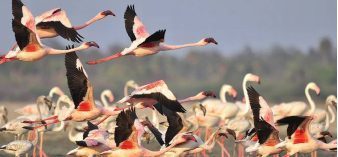
Greater flamingos extend stay in Pulicat

Greater flamingos extend stay in Pulicat
Naturalists surprised, say a study is needed on the movement of the birds
The extended stay by greater flamingos at Pulicat Lake has surprised naturalists and bird lovers.The migratory birds usually stay between September and March in the part of the lake that falls within Andhra Pradesh limits. But their stay for four additional months in the lake falling within Tamil Nadu has surprised naturalists, who are unable to figure out why it has happened.
A big colony of greater flamingos numbering nearly 1,500 is being seen in Annamalaicherry village on Pulicat lake. This village is located on the southern side of the lake. K.V.R.K. Thirunaranan of The Nature Trust said that over the last few years, greater flamingos have been extending their stay at the sanctuary.
Normally, one can see the greater lamingos on the northern part of the lake, which falls under the Andhra Pradesh side and the colony occupies the lake until March. Once the water level increases, they move to the southern part of the lake, in Tamil Nadu, he said.
Mr Thirunaranan said Annamalaicherry is a haven for the bird watchers, as one can sight more than 100 species of birds including flamingos. “A proper study needs to be taken up on the movement of the flamingos from the northern part of the lake to the southern part,” he said.
A couple of years ago, the State Forest department entrusted the bird survey work in Annamalaicherry to a group of naturalists, but this is not continuing any more, said bird watchers.
Murugavel of the Environment Monitoring and Action Initiating said the movement was mainly due to availability of feed. Mostly, adult flamingos were seen with juveniles at the lake. Rarely, lesser flamingos also came to the southern part of the lake, he said.Naturalists said the State government has decided to take 6.46 hectares of l and from Annamalaicherry, Periamangadu and Pazhaverkadu falling within the sanctuary area.
While fish-landing centres would come up at the first two places, in the third place the land will be used for constructing an evacuation shelter. Creating such facilities in the sanctuary would have a negative impact on the birds that colonise the sanctuary, they said. At present a Range officer is taking care of the management of both the Pulicat and Vedanthangal bird sanctuaries. Instead, officials should post one Range officer each to the sanctuaries, they said.
Scientific name:
Phoenicopterus
Higher classification:
Phoenicopteridae
Speed: James’s flamingo:
60 km/h
Mass: Greater flamingo:
2 – 4 kg,
Mass: Lesser flamingo:
1.2 – 2.7 kg,
Mass: James’s flamingo:
2 kg
Height: Greater flamingo:
1.1 – 1.5 m,
Height: Lesser flamingo:
80 – 90 cm,
Height: James’s flamingo:
91 cm
Did you know: In common, adult flamingos are either red, green, or somewhere between
Flamingos or flamingoes are a type of wading bird in the family Phoenicopteridae, the only family in the order Phoenicopteriformes. There are four flamingo species in the Americas and two species in the Old World.








